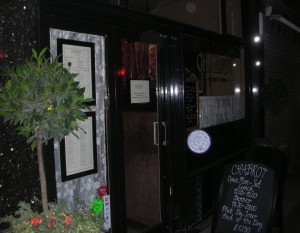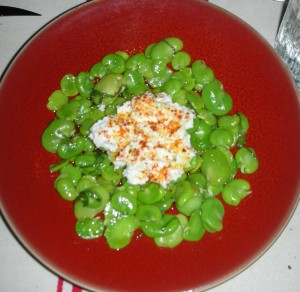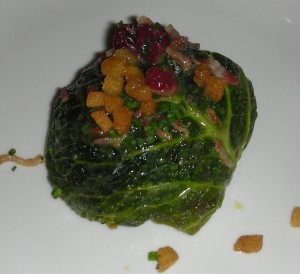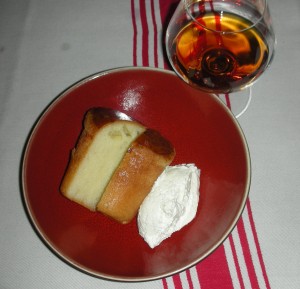
When Canadian friends are going to London the question they never ask is “What is the best restaurant in London?” What they do want to know is “Where is a good little place to eat that doesn’t cost the earth?” So I have been looking for such a gem, while also thinking of next July when I’ll be hosting some Canadians over here for the Olympics, courtesy of Gold Medal Plates. Tonight we went to check out Chabrot, a 65-seat bistro in a tiny alleyway running between Knightsbridge and the park, just a pierre’s jetée from Harrods.
Open about three-and-a-half months, it’s the fulfilled ambition of four friends – society florist Pascal Lavorel, wine guru Philippe Messy, Yann Chevris, who set up a number of big-name spots such as Nahm, Nobu London and Atelier Joel Robuchon, and chef Thierry Laborde, who worked at Le Gavroche and with Alain Ducasse at Le Louis XV. The name this influential quartet chose refers to a ritual from the Dordogne whereby gourmands pour a little wine into the bottom of their soup bowls to allow every last drop of potage to be consumed. Suitably obsessive… The credentials of the partners caught my eye, to be sure, but so did the menu, gleaming with treats from the south-west of France – sardines marinated in white wine; grilled black pudding with cooked apple; whole roasted foie gras for two (or three); cabbage stuffed with veal, chestnut, foie gras and ceps… So off we went.
The premises are hard to find. Cabbies know Knightsbridge Green and there is a cluster of little restaurants in the knuckle of the laneway that turns back southwards to Knightsbridge. Chabrot lies to the north, up a narrow passage where cars cannot go. It’s a slender little property on two storeys run by a team of young and anxious French people who try very hard to be friendly. We were guided up the steep flight of stairs to a wedge of a salon with painted brick walls, a wooden floor, tiny tables clad in red-and-white striped linen of industrial tea-towel weight, hard wooden chairs and large framed sepia photographs of French bistro scenes. “This will be noisy when the other tables fill up,” we surmised – and so it proved. Good reviews have ensured the place is packed, even on a Tuesday night. A lone waitress coped womanfully with our storey, keeping her temper, bringing excellent crusty brown bread and sweet, firm butter, giving us time to read the menu carefully. The dishes here are unabashedly simple – almost too simple, some might say, though others would disagree. It’s a tough call.

A salad of broad beans and ewe cheese is a case in point. The wee dish offered some absolutely impeccable, timed-to-perfection and shelled broad beans with a hint of mint. They were crowned with a dollop of sweet, bland sheep’s milk cheese with the texture of cottage cheese and the same amount of flavour. A sprinkling of piment d’espalette powder, south-west France’s gentle answer to paprika, added a soupcon of seasoning. A dose of very good olive oil offered much more. It was a brilliant little dish, such as one makes for a picnic montage in a Merchant-Ivory film when love is running hot and smooth. Puritan gourmets say “oui, superbe,” but others who might have hoped for a bit more dash and imagination grumble.
Ditto a dish billed as warm duck liver paté. If you have made paté you know there’s a moment when everything is cooked and warm in the pan and ready to be mashed and pressed and cooled into a paté. One can’t help but taste it. Well this dish has arrested the process at that point, presenting a ramekin of warm chopped and sautéed duck liver with capers, herbs and oily juices. Beside it is a giant gougère, the size of three Yorkshire puddings with some Comté cheese baked into the crust. It’s hollow of course, as a gougère should be, but where most gougères are dainty and ethereral little bites this one is the size of a child’s head. So we break bits off and use the undulating hollows of choux pastry as receptacles for a little of the embryonic pate. It tastes wonderful but the premise is a little like eating raw cake mix. What might this dish have been if the paté had been made? As Bubble used to answer in Absolutely Fabulous, Who can say?
Marinated sardines in white wine vinegar are a yummy crowd-pleaser, the fillets firm and juicy, just tangy enough. They come topped with chopped cherry tomato, chopped white grapes for sweetness, shredded basil and tiny dice of oil-fried croutons, crunchy and juicy with good olive oil. Again, it’s lovely but far from special.

Mains loom out of the menu and I find I can’t resist the stuffed cabbage leaves – savoy leaves as it turns out – my favourite cabbage. Inside is a dense meatloaf of finely ground veal studded with soft nuggets of chestnut and cep, enriched with foie gras. On top are some crunchy little croutons and a few burst cranberries which bring the whole thing to life, for the flavours of the cabbage roll are gentle and wistful, like an auntie’s kiss on the forehead. The tart cranberries have decided to make trouble but there are too few of them to bring the too-too-solid flesh to life.
Grilled octopus skewers, partially breadcrumbed, are as tender as the night. That espalette paprika makes a repeat appearance but has nothing to say it didn’t say already. A warm salad of halved fingerling potatoes in olive oil and lemon juice is divine. “But is it art?” Again the question arises.
Paillard de veau is a piece of veal beaten and tortured until it’s as thin as vellum then grilled and sprinkled with rosemary and sage. Any Italian would scoff, having tasted the tender Milanese equivalent. A small mound of well-dressed salad leaves on the side of the plate murmur comments without getting involved.

Oui, we had desserts. A bowl of gariguette strawberries with crème chantilly – very nice but too polite and the cream was too sweet to be wicked. Praline ice cream – excellent, but ice cream usually is. I had a baba (okay mostly so I could look the waitress in the eye and say “a baba!”) but this was served in an unusual way. The baba lay in a bowl beside a pillow of crème chantilly looking enchanting, but as I admired it the server whispered that I must now choose one of three vintage Bas Armagnacs (at decidedly vintage prices) to complete the experience. There was also a cheaper hors d’age Armagnac she confessed, but she made a most discouraging face when she mentioned that one. I chose the 1979 and awesome it was, though I couldn’t make out the producer’s name on the label. The waitress poured it into a snifter and murmured that I should now soak the spongey, very fresh, slightly syrup-impregnated baba with the precious eau de vie. Quelle dilemma, mes amis! To pour or not to pour? Whether tis better to annoint the baba or save the armagnac til later – that is the question. I decided to soak my cake and eat it while cunningly saving half the generous snifter for a post-baba libation! Lights flash, bells ring! That is the right thing to do.
There is wine at Chabrot – a lovely list indeed, strong in french regional bottles from cool, well-chosen producers but at London prices, which are higher than we are used to in Canada. The final verdict? We had a good time but next time I will fall back on a more comfortable favourite across the road – Racine.
Closed on Sundays, Chabrot is open for lunch and dinner. 9 Knightsbridge Green, London SW1X 7QL, 207 225 2238, www.chabrot.co.uk.
